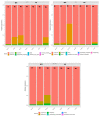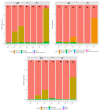Impact of Nisin and Nisin-Producing Lactococcus lactis ssp. lactis on Clostridium tyrobutyricum and Bacterial Ecosystem of Cheese Matrices
- PMID: 33921812
- PMCID: PMC8073774
- DOI: 10.3390/foods10040898
Impact of Nisin and Nisin-Producing Lactococcus lactis ssp. lactis on Clostridium tyrobutyricum and Bacterial Ecosystem of Cheese Matrices
Abstract
Clostridium tyrobutyricum spores survive milk pasteurization and cause late blowing of cheeses and significant economic loss. The effectiveness of nisin-producing Lactococcus lactis ssp. lactis 32 as a protective strain for control the C. tyrobutyricum growth in Cheddar cheese slurry was compared to that of encapsulated nisin-A. The encapsulated nisin was more effective, with 1.0 log10 reductions of viable spores after one week at 30 °C and 4 °C. Spores were not detected for three weeks at 4 °C in cheese slurry made with 1.3% salt, or during week 2 with 2% salt. Gas production was observed after one week at 30 °C only in the control slurry made with 1.3% salt. In slurry made with the protective strain, the reduction in C. tyrobutyricum count was 0.6 log10 in the second week at 4 °C with both salt concentration. At 4 °C, nisin production started in week 2 and reached 97 µg/g after four weeks. Metabarcoding analysis targeting the sequencing of 16S rRNA revealed that the genus Lactococcus dominated for four weeks at 4 °C. In cheese slurry made with 2% salt, the relative abundance of the genus Clostridium decreased significantly in the presence of nisin or the protective strain. The results indicated that both strategies are able to control the growth of Clostridium development in Cheddar cheese slurries.
Keywords: Cheddar cheese slurry; Clostridium tyrobutyricum; Lactococcus lactis; Nisin; antimicrobial peptides; dairy products; protective starter.
Conflict of interest statement
The authors declare that the research was conducted in the absence of any commercial or financial relationships that could be construed as a potential conflict of interest.
Figures













Similar articles
-
Effect of Lactococcus lactis expressing phage endolysin on the late blowing defect of cheese caused by Clostridium tyrobutyricum.Int J Food Microbiol. 2020 Sep 16;329:108686. doi: 10.1016/j.ijfoodmicro.2020.108686. Epub 2020 May 26. Int J Food Microbiol. 2020. PMID: 32516659
-
Inhibition of Clostridium tyrobutyricum in Vidiago cheese by Lactococcus lactis ssp. lactis IPLA 729, a nisin Z producer.Int J Food Microbiol. 2003 Aug 15;85(1-2):23-33. doi: 10.1016/s0168-1605(02)00478-6. Int J Food Microbiol. 2003. PMID: 12810268
-
Utilization of cheddar cheese containing nisin as an antimicrobial agent in other foods.Int J Food Microbiol. 1994 Dec;24(1-2):227-38. doi: 10.1016/0168-1605(94)90121-x. Int J Food Microbiol. 1994. PMID: 7703016
-
Inhibition of Listeria innocua in cheddar cheese by addition of nisin Z in liposomes or by in situ production in mixed culture.Appl Environ Microbiol. 2002 Aug;68(8):3683-90. doi: 10.1128/AEM.68.8.3683-3690.2002. Appl Environ Microbiol. 2002. PMID: 12147460 Free PMC article.
-
Effects of Lactococcus lactis on colorectal cancer in various terms: a narrative review.Ann Med Surg (Lond). 2024 Apr 4;86(6):3503-3507. doi: 10.1097/MS9.0000000000002030. eCollection 2024 Jun. Ann Med Surg (Lond). 2024. PMID: 38846866 Free PMC article. Review.
Cited by
-
Effects of Protective Lacticaseibacillus casei VC201 Culture on Late Blowing Prevention, Lipid Profile, and Sensory Characteristics of Valtellina Casera PDO Cheese During Ripening.Foods. 2025 Jul 10;14(14):2433. doi: 10.3390/foods14142433. Foods. 2025. PMID: 40724254 Free PMC article.
-
Enhancing safety and quality in the global cheese industry: A review of innovative preservation techniques.Heliyon. 2024 Nov 19;10(23):e40459. doi: 10.1016/j.heliyon.2024.e40459. eCollection 2024 Dec 15. Heliyon. 2024. PMID: 39654744 Free PMC article. Review.
-
Clean Label Approaches in Cheese Production: Where Are We?Foods. 2025 Feb 26;14(5):805. doi: 10.3390/foods14050805. Foods. 2025. PMID: 40077507 Free PMC article. Review.
-
Multiplex-PCR Detection of Clostridium tyrobutyricum, Clostridium butyricum, and Clostridium sporogenes in Raw Milk for Cheesemaking.Life (Basel). 2024 Aug 30;14(9):1093. doi: 10.3390/life14091093. Life (Basel). 2024. PMID: 39337877 Free PMC article.
-
Bacteriocin-Based Synergetic Consortia: a Promising Strategy to Enhance Antimicrobial Activity and Broaden the Spectrum of Inhibition.Microbiol Spectr. 2022 Feb 23;10(1):e0040621. doi: 10.1128/spectrum.00406-21. Epub 2022 Feb 16. Microbiol Spectr. 2022. PMID: 35170996 Free PMC article.
References
-
- Bermúdez J., González M.J., Olivera J.A., Burgueño J.A., Juliano P., Fox E.M., Reginensi S.M. Seasonal occurrence and molecular diversity of clostridia species spores along cheesemaking streams of 5 commercial dairy plants. J. Dairy Sci. 2016;99:3358–3366. doi: 10.3168/jds.2015-10079. - DOI - PubMed
-
- Gómez-Torres N., Garde S., Peirotén Á., Ávila M. Impact of Clostridium spp. on cheese characteristics: Microbiology, color, formation of volatile compounds and off-flavors. Food Control. 2015;56:186–194.
-
- McSweeney P., Fox P. Cheese: Chemistry, Physics, and Microbiology. Volume 1. Elsevier; Amsterdam, The Netherlands: 2004. Metabolism of residual lactose and of lactate and citrate; pp. 361–371.
-
- Klijn N., Nieuwenhof F., Hoolwerf J.D., van der Waals C., Weerkamp A.H. Identification of Clostridium tyrobutyricum as the causative agent of late blowing in cheese by species-specific PCR amplification. Appl. Environ. Microbiol. 1995;61:2919–2924. doi: 10.1128/AEM.61.8.2919-2924.1995. - DOI - PMC - PubMed
Grants and funding
LinkOut - more resources
Full Text Sources
Other Literature Sources
Molecular Biology Databases

